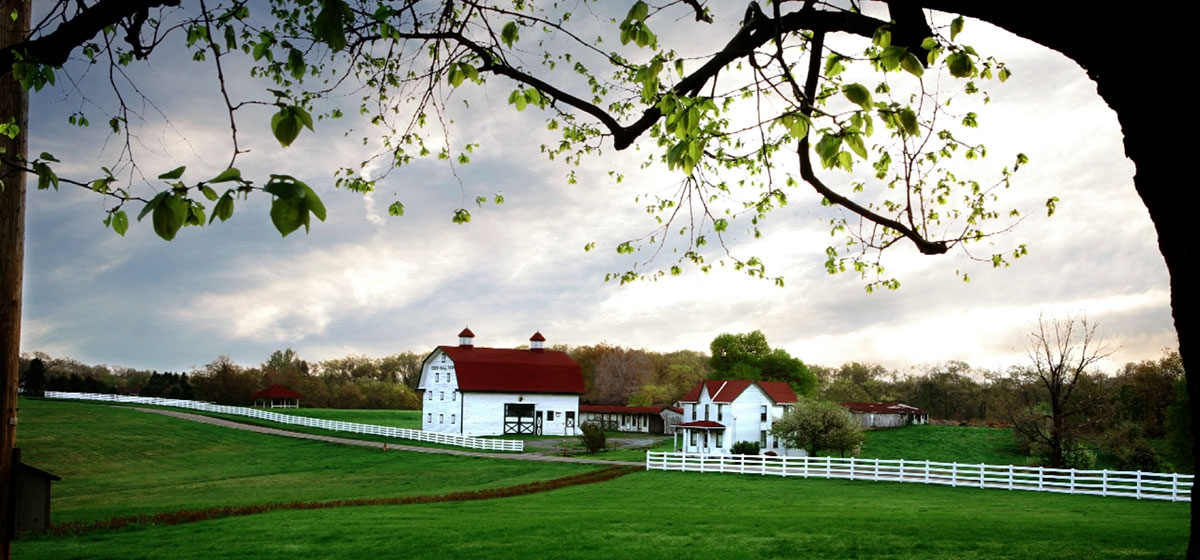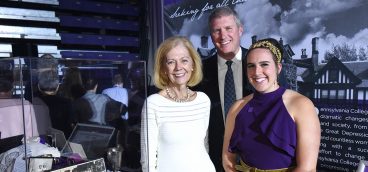High-Tech Sylvania

On a cool morning late in 2006, the phone rang in Esther Barazzone’s office, a suite overlooking Chatham University’s cozy Shadyside campus. Preoccupied by the re-accreditation of the undergraduate women’s program and preparations for new graduate degrees, the president was unprepared for the question she heard on the line from Dan Onorato’s office: Would Chatham possibly be interested in a 388-acre farm in Richland Township?
The unconventional offer of Eden Hall Farm, the last large undeveloped parcel in the go-go North Hills, would give the school a property 10 times the size of its urban home. Its orchards, forests and wetlands offered a staging ground for environmental field studies, a legacy Chatham claimed from the work of its most famous alumna, Rachel Carson. But the few mid-century buildings on the site were nothing like classrooms. The farm site was a 40-minute drive from the city. And it would require a massive, decade-long investment to create an academic institution from the ground up.
Barazzone pondered the opportunity for a year. And then she said yes.
Her 25-mile leap of faith across the Allegheny River is likely to define not only the university’s next chapter, but also how academic America interprets the brand-new field of sustainability. She recently unveiled a $60 million plan, drawn by the nation’s foremost green designers, which will break ground this summer. The first graduate students in the nation’s second school of sustainability will arrive in fall 2012.
If you’re unsure of what studying sustainability entails, beyond a tuition payment, you’re not alone. Like upstart disciplines before it—sociology, environmental science, or even physics—the subject is still being defined, its major texts yet to be written. But as a frame for examining the economic, agricultural, health and energy decisions that will sustain human life on earth, it’s rapidly drawing attention from idealistic young students and big thinkers. Among its luminaries are E.O. Wilson, David Suzuki, John Holmberg, and Bob Berkebile. And Berkebile—a 2009 Heinz Award winner whose Kansas City firm, Berkebile Nelson Immenschuh McDowell, was just named the American Institute of Architects (AIA)’s firm of the year—is the architect who created Eden Hall’s master plan.
“While we have a lot of new technology, starting on this unique piece of the plan is what changes the equation,” explains the affable Berkebile, who originated the LEED standards for the U.S. Green Building Council. “It starts at the headwaters—two streams [that are] ephemeral on site. Treating every drop of water that falls as a precious resource, and using that as a guiding principle, changes the community equation, the educational research and the whole sense of reconnecting ourselves with nature.” The plan that his firm developed with landscape architects Andropogon, of Philadelphia, calls for smart buildings well beyond LEED standards, demonstration projects for hydroponics and organic agriculture, and regenerated forests and waterways—as well as restaurants, theaters and public art.
To Barazzone, teaching sustainability on a site designed with sustainable systems made sense. The school has emphasized environmental studies since the founding of its Rachel Carson Institute in 1989, and launched a popular Master’s degree in food studies last fall. The degree is one of 18 graduate programs that Chatham has launched since 2007, squeezing campus facilities.
“We were bursting at the seams—absolutely land-deprived,” explains the beaming president, universally called “Esther” on campus. Since arriving at Chatham in 1992, she has driven an expansion that has added 28 new curricula, invested $75 million in campus improvements and quadrupled enrollment (though undergraduate numbers still hover at the traditional level of 600 women.) The school had already repurchased some Fifth Avenue properties sold in the 1980s and was searching for space beyond the genteel mansions of Woodland Road.
In some ways, Chatham’s recent growth spurt mirrors that of Richland Township. This booming municipality on the northern edge of Allegheny County has notched a 20 percent population increase (to nearly 12,000 residents) over the past decade. Pine-Richland School District’s vast new Eden Hall Upper Elementary School, adjacent to the new university site, serves 1,000 students. New nearby residential developments offer half-acre lots for $400,000, and the neighborhoods usually combine the words park, estates, manor, and heights in their names.
But Eden Hall Farm was off-limits to hungry developers. Long after it served as a home for Heinz executive Sebastian Mueller, it was a summer haven for Heinz’s working women, with a dairy barn, stables and hand-grown crops. Mueller, who outlived his heirs, created the Eden Hall Foundation to run the farm and donate to causes in health, education and social welfare. But by the mid-2000s, its trustees, no longer willing to subsidize its dwindling use, sought to donate the land for another public purpose. A county park? “The idea interested [Dan Onorato], but there was no surplus in his budget [to maintain the property],” recounts John Mazur, the foundation’s treasurer. When the focus turned to universities, the one with a history of supporting both women and environmental studies was an obvious choice.
“In our grantmaking, we always like a project with a women’s component. That made it more attractive,” says Mazur of the $8.5 million gift to Chatham. “We did a purpose check—wow, can you think of anything better?”
The 2008 agreement between Eden Hall and the university came on the same day Chatham finalized its purchase of the Eichleay building on nearby Penn Avenue, and kickstarted what Barazzone calls “a learning year.”
“We put all the senior college officers in my SUV, and off we go,” she says, describing visits to other universities with sustainability programs. Among them were Berea and Warren Wilson colleges, small neighboring institutions in Kentucky. The group also found ideas at Arizona State University, which founded the country’s first School of Sustainability in 2007. But none offered an exact model for the nation’s second and Barazzone turned to other Pittsburghers for advice.
“Jared Cohon [CMU’s president] said, ‘don’t model [this project] on a small liberal arts college,’” she recalls. “Bobby Vagt [president of The Heinz Endowments] urged us to look forward to the 22nd century.” Aris Candris, CEO of Westinghouse, also encouraged Chatham’s strategy.
With more than $750,000 in planning funds from the PNC and R.K. Mellon Foundations, Chatham hired the most prominent sustainable designers in the country. The 2010 BNIM/Andropogon plan divides the campus into three environmental zones: conserved lands, arable lands, and systems that connect residents to the environment. The latter will create natural wastewater and groundwater filtration systems that exceed LEED standards. Experimenting with geothermal, photovoltaic, solar and other energy sources, the campus will aim for zero carbon emissions. (In 2007, Barazzone signed the American College and University Presidents’ Climate Commitment, pledging to develop a climate-neutral campus; the group now has nearly 700 members.) All development will cluster along existing roads, leaving slopes and streams undisturbed.
Chatham will break ground on the first $15 million phase of construction this summer, concentrating on the two red-roofed barns on the western side of Ridge Road. The existing structures will house classrooms, a reception area, a stage and cafe space. A new Eco-Center, north of the main barn, also will be used for classrooms. Conferences and classes will continue at the existing Mueller house and lodge across the road. Later phases call for development of three other districts, including living quarters for 1,200 residents, connected by paths and pedestrian bridges to the core.
Though neighbors have demanded—and received—changes in the master plan during public hearings on issues such as parking, the consensus is that Chatham’s plans are on target.
“I can’t imagine any development that’s more respectful of the land than this one,” says Richland Township Manager Dean Bastianini. He says Eden Hall fits the objectives of the township’s existing comprehensive plan. “Our objective is to balance growth and new development with the characteristics that made [the area] attractive for folks to begin with.” While local traffic will increase with activity on campus, Bastianini says that the school will pay impact fees for signals and intersections and that its overall impact will be smaller than standard residential development.
New Dean David Hassenzahl says that each phase of the campus development will become a laboratory for testing and comparing new systems. “It won’t have the standard infrastructure of power lines or water lines. We will use different building management practices, learning as we build the early phases for later.”
Defining the scope of its research as “affordable and replicable,” Hassenzahl expects the School of Sustainability and the Environment “will change the ways we behave.” The bearded dean, formerly dean of environmental science at the University of Nevada-Las Vegas, adds another prediction: “It will be enormously fun.”
Esther Barazzone expects the campus to be a destination for architects and others (including 3,000 members of the Association for the Advancement of Sustainability in Higher Education, who will meet in Pittsburgh this fall). But she argues that its intellectual reach will be much broader.
“This is not an academic banana republic. There will be synergy with our other disciplines.” She insists, too, that the university’s investment for the future makes sense. Comparing the projected cost of $60 million to the cost of the new athletic center on the Woodland Road campus—$18 million—she argues that the Eden Hall project is “not a lot for what’s created.”
With a brand-new campus in a thriving young community, can Barazzone envision relinquishing the Shadyside campus? She firmly refutes the idea. “We have strong reasons to be in both places,” she says. “We would not leave our historic campus, and graduate students [such as those in the health sciences] need to be in the city. And few institutions get to build from the land up. This gives us a challenge—on how to be integrated.”




